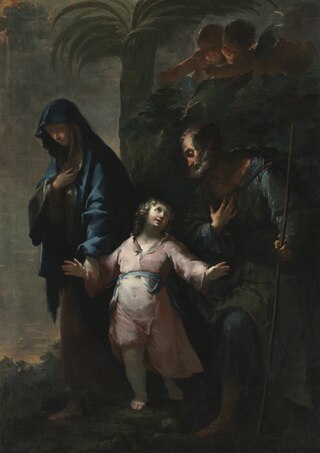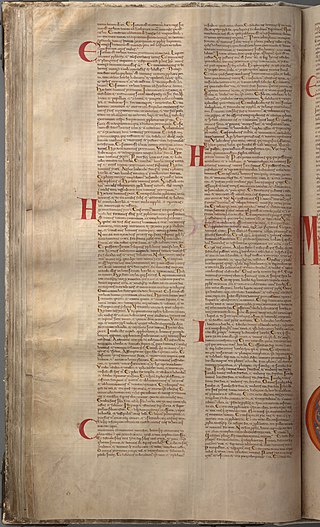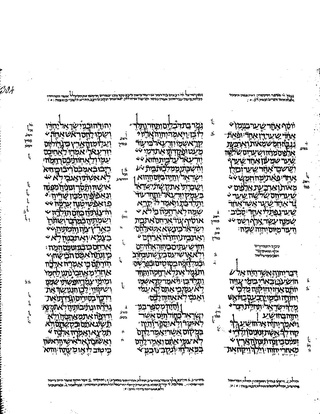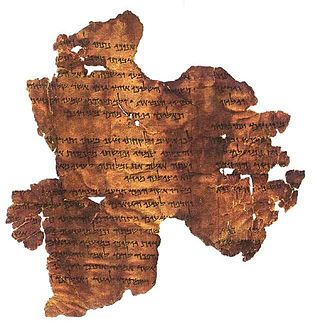Related Research Articles

The Messiah in Judaism is a savior and liberator figure in Jewish eschatology who is believed to be the future redeemer of the Jews. The concept of messianism originated in Judaism, and in the Hebrew Bible a messiah is a king or High Priest of Israel traditionally anointed with holy anointing oil. However, messiahs were not exclusively Jewish, as the Hebrew Bible refers to Cyrus the Great, Achaemenid Emperor, as a messiah for his decree to rebuild the Jerusalem Temple.

Matthew 2:23 is the twenty-third verse of the second chapter of the Gospel of Matthew in the New Testament. The young Jesus and the Holy Family have just returned from Egypt and in this verse are said to settle in Nazareth. This is the final verse of Matthew's infancy narrative.

The War of the Sons of Light Against the Sons of Darkness, also known as War Rule, Rule of War and the War Scroll, is a manual for military organization and strategy that was discovered among the Dead Sea Scrolls. The manuscript was among the scrolls found in Qumran Cave 1, acquired by the Hebrew University of Jerusalem and first published posthumously by Eleazar Sukenik in 1955. The document is made up of various scrolls and fragments including 1QM, and 4Q491–497. It is possible that The War of the Messiah is the conclusion to this document. The 4Q491–497 fragments were published by Maurice Baillet in Discoveries in the Judaean Desert, volume 7 and comprise a shorter recension of the War Scroll.

Isaiah 53 is the fifty-third chapter of the Book of Isaiah in the Hebrew Bible or the Old Testament of the Christian Bible. This book contains the prophecies attributed to the prophet Isaiah and is one of the Nevi'im. Chapters 40 to 55 are known as "Deutero-Isaiah" and date from the time of the Israelites' exile in Babylon.
The books of the New Testament frequently cite Jewish scripture to support the claim of the Early Christians that Jesus was the promised Jewish Messiah. Scholars have observed that few of these citations are actual predictions in context; the majority of these quotations and references are taken from the prophetic Book of Isaiah, but they range over the entire corpus of Jewish writings.

The Rule of the Blessing (1QSb) is a very fragmentary text once thought to be part of the text of the Community Rule scroll found in Cave 1 at Qumran as part of the Dead Sea Scrolls. It is added as one of two appendices following the book of the Community Rule, on one of the first seven scrolls discovered at the Qumran site. The Rule of the Blessing includes three benedictions for use during the eschaton: one for the general assembly of the eschatological Tribe of Israel, which describes a sort of “living water” bringing them into a new covenant with God, one concerning the Kohen (priest) Sons of Zadok, chosen by God who will act “like angels” and lead Israel after the War. The third prayer is that for the messianic meal, to bless the “Prince,” or Davidic messiah, who has come to deliver Israel. Similar prayers are found elsewhere in the scrolls, and some believe that this particular manuscript may be a collection of prayers for general, daily use.
11Q13, also 11QMelch or the Melchizedek document, is a fragmentary manuscript among the Dead Sea Scrolls which mentions Melchizedek as leader of God's angels in a war in Heaven against the angels of darkness instead of the more familiar Archangel Michael. The text is an apocalyptic commentary on the Jubilee year of Leviticus 25. The Dead Sea Scrolls contain texts in Hebrew, Aramaic and Greek, the language of 11Q13 is Hebrew, date of composition is circa 100 BCE.
4Q521 or the Messianic Apocalypse is one of the Dead Sea Scrolls found in the Cave 4 near Qumran.

Zechariah 12 is the twelfth of the 14 chapters in the Book of Zechariah in the Hebrew Bible and the Old Testament of the Christian Bible. This book contains the prophecies attributed to the prophet Zechariah, and is a part of the Book of the Twelve Minor Prophets. This chapter is a part of a section consisting of Zechariah 9–14. This chapter and chapter 13 verses 1–6 are a section, forming a three-section "entity" with 13:7–9 and 14:1-21.
Isaiah 52 is the fifty-second chapter of the Book of Isaiah in the Hebrew Bible or the Old Testament of the Christian Bible. This book contains the prophecies attributed to the prophet Isaiah, and is one of the Books of the Prophets. Chapters 40-55 are known as "Deutero-Isaiah" and date from the time of the Israelites' exile in Babylon. This chapter includes from verse 13 the start of the fourth of the songs of the "Suffering Servant".
Isaiah 9 is the ninth chapter of the Book of Isaiah in the Hebrew Bible or the Old Testament of the Christian Bible. This book contains the prophecies attributed to the prophet Isaiah, and is one of the Nevi'im.
Isaiah 60 is the sixtieth chapter of the Book of Isaiah in the Hebrew Bible or the Old Testament of the Christian Bible. This book contains the prophecies attributed to the prophet Isaiah, and is one of the Books of the Prophets. Chapters 56–66 are often referred to as Trito-Isaiah, with chapters 60–62, "three magnificent chapters", often seen as the "high-point" of Trito-Isaiah. Here, the prophet "hails the rising sun of Jerusalem’s prosperity".
Isaiah 11 is the eleventh chapter of the Book of Isaiah in the Hebrew Bible or the Old Testament of the Christian Bible. This book contains prophesies attributed to the prophet Isaiah. This chapter can be divided into two main parts, verses 1–9 and verses 11–16, with verse 10 as a connecting statement between them. The New International Version entitles the chapter "The Branch from Jesse".

Isaiah 14 is the fourteenth chapter of the Book of Isaiah in the Hebrew Bible or the Old Testament of the Christian Bible. This book contains the prophecies attributed to the prophet Isaiah, and is one of the Books of the Prophets.
Isaiah 19 is the nineteenth chapter of the Book of Isaiah in the Hebrew Bible or the Old Testament of the Christian Bible. This book contains the prophecies attributed to the prophet Isaiah, and is one of the Books of the Prophets. This chapter focuses on Egypt.
Isaiah 27 is the twenty-seventh chapter of the Book of Isaiah in the Hebrew Bible or the Old Testament of the Christian Bible. This book contains the prophecies attributed to the prophet Isaiah, and is one of the Books of the Prophets. Chapters 24-27 of Isaiah constitute one continuous poetical prophecy, sometimes called the "Isaiah Apocalypse".

Micah 4 is the fourth chapter of the Book of Micah in the Hebrew Bible or the Old Testament of the Christian Bible. This book contains the prophecies attributed to the prophet Micah, and is a part of the Book of the Twelve Minor Prophets.

Zechariah 3 is the third of the 14 chapters in the Book of Zechariah in the Hebrew Bible or the Old Testament of the Christian Bible. This book contains the prophecies attributed to the prophet Zechariah, and is a part of the Book of the Twelve Minor Prophets. The chapter contains the vision of Joshua, the high priest, being cleansed before God. It is a part of a section consisting of Zechariah 1–8.

Zechariah 2 is the second of the 14 chapters in the Book of Zechariah in the Hebrew Bible or the Old Testament of the Christian Bible. This book contains the prophecies attributed to the prophet Zechariah, and is a part of the Book of the Twelve Minor Prophets. This chapter is a part of a section consisting of Zechariah 1–8. It records the third of eight visions received by the prophet, followed by an oracle calling the exiles to return to the city where Yahweh is about to dwell and all nations will come.

Hosea 3 is the short, third, chapter of the Book of Hosea in the Hebrew Bible or the Old Testament of the Christian Bible. This book, part of the Book of the Twelve Minor Prophets, contains the prophecies attributed to the prophet Hosea, son of Beeri, and this chapter refers autobiographically to Hosea's marriage to a woman who is an adulterer. His purchase of her from a paramour is treated in the Jamieson-Fausset-Brown Bible Commentary as a symbol of "Israel's condition in their present dispersion, subsequent to their return from Babylon".
References
- ↑ ISBN 0-06-076662-X pp. 368–371
- ↑ Ostling, Richard N. (Sep 21, 1992). "Is Jesus In the Dead Sea Scrolls?". Time Magazine. 140 (12): 56–57. Archived from the original on April 9, 2009. Retrieved 13 February 2013.
- ↑ Tabor, James D. (Nov–Dec 1992). "A Pierced or Piercing Messiah? – The Verdict Is Still Out". Biblical Archaeology Review. 18 (6): 58–59. Retrieved 13 February 2013.
- Vermes, G. "The Oxford Forum for Qumran Research: Seminar on the Rule of the War from Cave 4 (4Q285)," Journal of Jewish Studies 43 (Spring 1992):85-90.
- Wise, Michael, Martin Abegg, Jr., and Edward Cook, trans. A New Translation: The Dead Sea Scrolls. N.p.: n.p., n.d. Print.